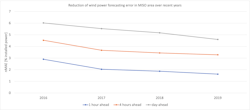Precise Generation Forecasting for Wind Farms and Solar Plants
Forecasts of wind and solar energy have proven to be an indispensable necessity when integrating these forms of fluctuating renewable energies into the energy supply system. Transmission system operators (TSOs), Independent System Operators (ISOs), Independent System Operators (ISOs), energy traders and plant operators around the world are able to rely on sophisticated forecasting products from various commercial suppliers. Over the past decade, these products have now become increasingly more accurate tools for managing these weather dependent sources of generation.
To predict the generation output of wind and solar farms as accurately as possible, forecasting providers use a variety of different methods and models. Specially developed forecast models for weather conditions that are particularly difficult to predict, such as thunderstorms, wind ramps or snow, as well as estimates of power output, also play a decisive role in precision.
Rapid Growth of Renewable Energy Sources
The proportion of wind and solar power in the electricity generation mix is increasing rapidly worldwide, and as the total installed capacity increases, so does the output of individual windfarms and solar plants. For example, in the USA, these windfarms often cover gigantic areas with capacities that have already exceeded the gigawatt mark in some cases. Currently, 18 of 26 onshore windfarms worldwide with more than 500 MW generation capacity are located in the US therefore, precise forecasts of generation output are becoming increasingly important. This is because power generation from windfarms or solar plants naturally fluctuate with the weather that requires TSOs or ISOs, respectively, to react quickly to these fluctuations in order to ensure grid stability. Events such as an unforeseen cloud formation over a solar farm or sudden katabatic winds at a windfarm, each with several hundred megawatts of capacity, often require prompt action.
The stability of electrical grid is not the only challenge as short-term forecasts of power generation are crucial for the successful trading of wind or solar energy on the power exchanges. Furthermore, if the trader cannot deliver and fulfil energy contracts on the previously agreed date, they may face substantial additional costs, depending on the market trading arrangements. Hence, traders lose income if they cannot rely on accurate forecasting and precise updates.
Complex Process
To provide reliable power generation forecasts even in the face of diverse and frequently changing weather situations, the forecasting providers have to use complex calculation models as well as a large volume of data. The German company energy & meteo systems, for example, use their own Previento and Suncast forecasting systems for windfarm and photovoltaic plants, and they continuously develop them further using actual plant output data and further sources of meteorological data from all parts of the world. The forecasting system is operated by energy & meteo in a 24/7 mode and supplies forecasting updates as a service to customers worldwide. Hence, subscribers of the service only have to establish interfaces to retrieve the forecasting data from the vendor and make actuals available in return. But there is no need for them to implement an infrastructure for the forecasting system, this remains with the vendor.
Previento and Suncast are based on physical models for calculating the generation capability. For this purpose, data from numerical weather forecasts from the meteorological services on local wind speed or local irradiation data are used. In addition to these weather forecasts and the exact location of the source of generation, the most important data for this basic forecast includes the hub height of the wind turbines or the orientation and inclination of the solar modules. The forecasts can be further refined by taking into account additional measurement data of the feed-in and historical weather data in the respective model. In this way, the forecasts are calibrated more precisely with increasing data density.
The forecast quality is further increased by a so-called combined or blended forecast. For this purpose, the model uses weather forecasts from several different weather services and weights them according to their performance in the past with a special consideration of seasons of the year or specific weather conditions. According to this weighting, the combined forecast is then determined, whose precision usually significantly exceeds that of the underlying basic forecasts.
Finally, a short-term forecast takes into account currently collected real-time production data to adjust the power forecast to current weather and feed-in conditions. This update is critical to ensure high accuracy forecasts for the up-coming minutes and hours. Depending on the requirements, such an update can take place in short time intervals, for example every five minutes for the US Real-time Market Dispatch or every 15 minutes for the German energy market.
Wind Turbine Icing
One of the greatest challenges in wind power forecasting in the USA is the impact of icing on wind- farms. During Artic storms in winter, very cold air from Canada can make its way down to the Gulf of Mexico within a time period of 48 hours or less. These cold fronts are often accompanied by freezing rain, giving rise to the formation of ice shields on the rotor blades or on the instrumentation of windfarms. For reasons of security, the wind arms shut down their operations, which can lead to an unexpected decrease of several gigawatts in the wind power production. These icing events can be very challenging, for example, to the TSOs, as they have to make sure that there is sufficient reserve power available for these instances.
To handle these situations, energy & meteo systems developed an icing forecast model which is part of the Previento system. It generates icing scenario forecasts, for example, worst case and best scenario, to helping the TSO to estimate the potential loss of renewable generation due to icing and time to react in order to avoid financial loss or equipment damage. The German energy service provider offers situational awareness reports and regularly updated weather warnings, which provide additional, more detailed information on the predicted icing events.
Snow on PV Modules
In the further development of solar forecasting systems, a particular focus is now being centered on improving the output power forecasts in the event of snow conditions as this can cause significant forecast errors. For example, snow on the PV system significantly reduces solar production depending on the depth of the snow cover. To address this, the forecast model provides a special snow correction procedure that uses information from available weather models. Data to be considered includes, for example, expected temperature and snow cover information. A snow correction is then applied to the generation forecast based on these values.
"Behind the Meter" Estimations
By definition, ‘Behind-the-Meter’ (BTM) generation production is difficult for the ISO or distribution network operator (DNO) to estimate, in particular, the hidden production of roof-top PV installations. Therefore, service providers such as energy & meteo systems also supply projections of the current solar power feed-in in real time for various grid areas in the western United States.
The basis for the solar projections is access to production data from several tens of thousands of reference systems in the U.S. from leading photovoltaic inverter companies. The feed-in is precisely determined taking into account the regional distribution of the installed systems. For this purpose, the measured data of the rooftop systems available in the vicinity is extrapolated to the installed power of this area for each zip code and then added to the total installed generation of each grid area. This BTM extrapolation is used to monitor the current solar production and improve the regional solar short-term forecast and is, in addition, also crucial for forecasting the total demand in the area.
Dispatchable Intermittent Resource Program in the MISO Footprint
In order to be able to react quickly to power fluctuations and, if necessary, to precisely down regulate the windfarms, that cover huge areas, the US transmission system operator Midcontinent ISO (MISO) introduced the Dispatchable Intermittent Resource (DIR) in November 2010. The world's largest grid operator, with more than 22,000 MW of wind power installed in the area, is only able to manage this large quantity of wind power and guarantee grid stability by means of remote control and appropriate down regulations of individual wind farms.
energy & meteo systems has supported this process with its power forecasts from the very beginning. This includes precise high-resolution forecasts for the entire area of the ISO, delivered every five minutes and used directly for the DIR. The data processing has been optimized for this purpose so that the measurement of the current feed-in of the wind farms and solar parks is transmitted to MISO's system as a very-short-term forecast within less than one minute. Due to these short-term deliveries, the forecasting system must be as fail-safe as possible and highly available. By meeting these requirements, the German energy and software specialist is making a decisive contribution to grid stability in fifteen US States and the Canadian Province of Manitoba.
The forecast accuracy is an important issue and, in view of an increasing number of RE plants, needs to be improved continuously by the forecasting service providers. This process takes place at different points in the prediction chain. One particular focus is on the input data, i.e. numerical weather predictions and technical data from the assets, with the aim to extract the maximum benefit from the data. For example, energy & meteo systems increased the number of weather models used for power forecasts in the MISO as more sophisticated models with higher spatial resolution have become available in recent years. A second aspect is the implementation of new forecasting functions such as the aforementioned icing correction to support MISO in difficult weather situations with a high risk of unexpected production loss of wind farms. Over the last year’s energy & meteo systems was able to reduce the average forecasting error of the power predictions of the aggregated wind portfolio significantly.
About the Author
Matthias Lange
Dr. Matthias Lange attained his doctorate from the Carl von Ossietzky University of Oldenburg (Germany) on the subject of the uncertainty of wind power predictions. Prior to co-founding energy & meteo systems together with Dr Ulrich Focken in 2004, he was project leader for network integration and wind energy predictions at the Centre for Wind Energy Research ForWind in Oldenburg. Lange is managing director and co-founder of energy & meteo systems GmbH having been active in the wind and solar industry since 1999. He has successfully managed and implemented a large number of national and international customer projects in the field of the integration of fluctuating energy producers into the electricity grids and markets.







